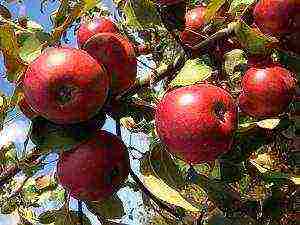Content
- 1 Breeding asters
- 2 What an aster looks like: a description of the plant
- 3 The best varieties of annual asters: photos and descriptions of flowers
- 4 Annual plants of the aster selection by G.V. Ostryakova
- 5 The most beautiful perennial asters: photos, names and descriptions
- 6 How to grow asters: reproduction of flowers by seeds and dividing a bush
- 7 Aster flower: description
- 8 Astra: the best perennial varieties
- 9 Early flowering asters the best varieties
- 10 Summer "stars" varieties
- 11 Autumn varieties
- 12 Varieties of annual asters
Perhaps, not a single household plot can do without aster flowers. These plants, for all their undeniable beauty, require minimal maintenance. Annual varieties are perfectly renewed by sowing seeds, and perennial forms can be spread throughout the garden by dividing the bush. Cultures are so diverse in height, size and color range of flowers that they can be used in any flower garden or mixborder.
The first descriptions of the aster plant have come down to our days from ancient times. So, when opening a royal tomb 2000 years ago near Simferopol, researchers found an image of an aster, and the ancient Greeks considered this flower an amulet.
The thin petals of an aster look like rays of distant stars, which is why the plant got its name (Latin aster - "star"). An ancient belief says that if you go out into the garden at midnight and stand among the asters, you can hear a quiet whispering. These are flowers that communicate with the stars. Already in ancient Greece, people were familiar with the constellation Virgo, which was associated with the goddess of love Aphrodite. According to ancient Greek myth, the aster arose from cosmic dust when the Virgo looked from the sky and cried. For the ancient Greeks, aster symbolized love. In China, asters symbolize beauty, precision, elegance, charm and modesty.
See how beautiful the aster flowers are in these photos:
Breeding asters
Perhaps, of the seed-propagated flower crops, aster is the most beloved in Russia. It is grown everywhere, in every garden plot the owner will find a place for this flower, and asters, in return, will delight the grower with their beauty. There are many varieties of asters, according to some reports, more than 4000 of them have been created in the world, and at least three hundred are actively used in floriculture. Breeders are working energetically to create new products.
Varieties are created in France, England, Denmark, Sweden, especially many varieties have been created in Germany. Domestic breeders have bred more than 100 varieties of asters.
Unfortunately, at present, the seeds of Russian asters are on sale less often than imported ones. This situation has arisen due to the destruction of the system of flower seed production in the country. Therefore, there are breeders, there are new varieties, but there is no mass seed production, and only a small part of the wonderful Russian asters can be purchased in a flower shop. But Russian varieties of annual asters grow better in our (far from being as mild as in Europe) growing conditions, and are more resistant to diseases. The same can be said for perennial forms. And breeding in European countries is aimed at creating varieties with a long flowering period, which is justified by a long growing season, because spring comes there earlier, and winter later than in Russia.
But at the same time, as a rule, the longer the flowering period, the longer the period from germination to the beginning of flowering. Therefore, most of the "European" varieties of late flowering (from germination to the beginning of flowering more than 115 days). Domestic asters bloom earlier and manage to fully manifest their best qualities before the autumn frosts.
Aster annual or Chinese belongs to the Asteracea Dum family of the genus Callistephus.
The name of the genus in translation from Greek means "beautiful wreath".
The genus Callistephus includes only one species Callistephus chinensis Ness, which received, widespread in floriculture under the name of the annual aster. Translated from Greek "aster" means a star. Wild aster was brought to Europe from China in 1728. And in 1745, forms with double inflorescences appeared in France. From France in 1752, the aster came to England, where Miller selected plants with double inflorescences of purple, white and red. And by the end of the 18th century, a large number of varieties with blue, purple, purple and pink inflorescences were added to them.
Asters gained especially wide popularity at the beginning of the 19th century after the florist Truffau in France bred luxurious plants with double peony-shaped inflorescences and thus attracted the special attention of all gardeners to asters. By the mid-19th century, gardeners had asters with inflorescences ranging from lightest to darkest tones. They tried more to get inflorescences consisting of tubular needle-shaped flowers.
Therefore, the oldest group is considered a group of tall tubular asters. In the 50s of the 19th century, the beautiful Peony aster was bred, then the Anemoid, and by 1860 some of the best varieties of asters were created - Tranquil, Chrysanthemum and Perfectin.
Later, the Horn-shaped aster, selected from the Pion-shaped, and the Acicular aster with accrete needle-like petals, appeared.
Since the end of the 19th century, Germany has become the main center for breeding and selection of asters, where most of the asters of the modern world assortment are created. At the beginning of the 20th century, asters began to be bred in the United States. The varieties obtained here are characterized by a large plant height and large inflorescences. At present, breeders from Germany, Denmark, Sweden, Poland, and the United States continue to work abroad to create new varieties of asters.
In Russia, gardeners have loved and grown asters since their appearance in the gardens of Europe, but they did not breed their own varieties and even received seeds from abroad. In our country, for the first time, he began to engage in aster selection in 1923, Professor S.N. Zhegalov at the experimental station of the Moscow Agricultural Academy. K.A. Timiryazev.
Later, from the beginning of the 50s of the 20th century, breeders worked on the development of new varieties: G.E. Christer in the Oryol region, A. Davydov in the Kursk and A. I. Kuznetsova in the Voronezh region. At present, scientists from the V.I. I.V. Michurin. A great contribution to the development of breeding work in the country was made by the All-Russian Research Institute of Plant Industry named after N.I. Vavilov. Work on the study of the annual aster was carried out by the laboratory of selection and seed production of flower crops VNIISSOK.
What an aster looks like: a description of the plant
Aster is a herbaceous, erect plant, light-loving, cold-resistant, tolerates spring and autumn frosts down to -4 ° C, as a rule, requires watering. Most of the roots are located at a depth of 15–20 cm, some of them penetrate even deeper into the soil, and therefore the aster is well supplied with water and nutrients. Damaged roots during planting or loosening are easily restored, which allows planting seedlings of various ages, as well as successfully transferring plants to a new place even in the budding and flowering phase.
Stem of aster, covered with stiff short hairs. The color of the stem is green, red, anthocyanin. Each aster shoot ends with one inflorescence. Branching of the main stem begins during budding, sometimes 2–4 days earlier.
When describing an aster flower, it is worth noting that tall and dwarf species branch most strongly, less average ones.
By height, the plants are divided into dwarf ones up to 20 cm, low 21-30 cm, average 31-60 cm, high 61-80 cm and very high, more than 80 cm. By the shape of the bushes, depending on the number of branches of the first-third order and their angle discharge are spherical, oval, columnar, pyramidal, wide strong, wide spreading.
The number of leaves on the main stem is not the same. For different groups of asters, it varies from 6 to 19.
Look at the photo - in the aster plant, the leaves located at the bottom of the stem have an oval-rhombic shape, the edges of the leaf blade are coarsely serrated, at the top the leaves are pointed:
Annual aster varieties often differ in leaf color. They are light green, green, dark green.
Aster inflorescence basket, consists of central bisexual tubular flowers, transitional and marginal false-reed female type.
The color of the inflorescences is varied: from white to all shades of blue, red, violet, pink, lilac. Less common varieties with yellow inflorescences. There are varieties with a two-color inflorescence, for example, the central ligulate flowers are white, and the marginal flowers are red.
There are no pure orange varieties. In terms of shape, inflorescences are divided into flat, flat-round, hemispherical and spherical. In diameter, inflorescences are small - 2-4 cm, medium-sized 4.1-6 cm, large 6.1-9 cm, very large 9.1-12 cm and "giant" more than 12 cm.
Inflorescences are non-double, semi-double, double and densely double.
The fruit is achene with a dense shell from narrow to wide-wedge-shaped, gray, brown, red and anthocyanin color from light to dark. 1 g contains 330-560 seeds. Germination lasts 2-3 years. The seeds swell and germinate rather quickly. At an optimum temperature of 18–23 ° C, mass shoots appear 4–7 days after sowing. According to the timing of the beginning of flowering, all aster varieties can be divided into seven groups: very early bloom within up to 95 days from the emergence of shoots; early varieties after 96–100 days; mid-early varieties bloom in 101-106 days; medium varieties 107–112 days; medium late 113–120 days; late 121–126 days; very late varieties over 126 days.
Terry varieties of asters are very decorative; they have a decorative period of one inflorescence that lasts 10–20 days. Non-double varieties bloom faster. In cut plants, the buds do not open, therefore, half-open aster inflorescences for bouquets should not be cut off.
Tubular (bisexual) flowers in the inflorescence bloom for 3-7 days, reed 33-52 days. The annual aster is characterized by self-pollination and cross-pollination, as a rule, within the same plant.
With a strong degree of terry, the pollination process is difficult. The fewer tubular flowers, the fewer seeds are formed; in inflorescences consisting only of reed flowers, the seeds are practically not tied. Therefore, when breeding or selecting terry forms or varieties, you should achieve reasonable limits of terry (no more than 80-85% in inflorescences located on the branches of the first order).
Ripening of seeds lasts 40-50 days after the beginning of flowering, however, incompletely ripe seeds can germinate. Freshly harvested seeds germinate poorly, they need time for post-harvest ripening (usually 6-10 days). A sign of seed ripening on a plant is wilting of reed flowers and the appearance of a cannon in wilted inflorescences.
Asters are used in different ways in floral decoration. They look very impressive in the fall with coniferous and evergreen shrubs. Compact bushes allow asters to be used singly and in groups. You can create flower groups from some asters by choosing plants according to the color and height of the bushes.
It should be remembered that tall varieties are bare from below, so it is advisable to plant lower perennials in front of them that retain foliage for a long time. Perennial asters are extremely hardy. In the fall, when frosts damage the inflorescences of gladioli, dahlias and other flower crops, asters are still fresh and give a beautiful cut.
Aster inflorescences do not bloom in water. Therefore, they are cut off completely in the morning, they stand in the water for a long time, without losing their freshness. Before you put the flowers in the water, the stems of the asters must be pruned and the lower leaves removed from the stem.Asters can stand in water for 3 weeks and the water should be changed at least 2 times every 5 days.
Next, you can familiarize yourself with the photos, names and descriptions of asters of annual varieties.
The best varieties of annual asters: photos and descriptions of flowers
The variety of bred varieties and groups of asters made it necessary to classify them to facilitate the work of flower growers in identifying and describing varieties. The most complete and convenient is the classification developed by N.A. Petrenko (1973). It is based on the decorative qualities of various varieties. All varieties are divided into 3 classes reed, tubular and transitional. The first class includes varieties and varieties, the decorative effect of inflorescences of which is made up only of tubular flowers, the second class includes varieties and varieties with reed and tubular flowers, and the third class of varieties and varieties with reed flowers only. Classes are subdivided according to the structure of inflorescences into 10 types, which in turn include 44 cultivar types, differing from each other not only in the structure of inflorescences, but in their shape, size, as well as the shape of flowers and plant habit. Varieties within variety types, as a rule, differ only in color.
The following groups of annual asters are most popular:
Variety American Beauty
Variety type Victoria
Variety type Voronezh
Variety Duchess
Variety Dwarf Royal
Variety Laplata
Variety Peony
Variety Pomponnaya
Variety Princess
Radio type
Variety pink
Variety type Unicum
Variety type Rosovidnaya. Reed class, hemispherical type. Medium early varieties. The bush is strong, columnar, 50–70 cm high, up to 40 cm in diameter. Peduncles are well leafy, strong, up to 40 cm long. Inflorescences are hemispherical, double, 7–10 cm in diameter. Ligulate flowers are wide, completely covering the disc of yellow tubular flowers. The plant has up to 20 inflorescences on the shoots of the first and second orders. Duration of flowering up to 60 days. Many varieties are affected by Fusarium. The use is universal.
Variety type Victoria. Reed class, tiled type. Medium early varieties. The bush is strong, columnar, 40–65 cm high, 25–40 cm in diameter. Inflorescences are flat-round or hemispherical, double or densely double, 9-10 cm in diameter, up to 25 pcs. on the plant. The ligulate flowers are wide, short, tiled, often completely covering the small central disc of yellow tubular flowers. Duration of flowering up to 50 days. Fusarium resistant. The use is universal.
Variety type Voronezhskaya. Created by Voronezh breeders, it combines the features of two varieties (Rosovidnaya and Victoria). Very early to medium flowering time. Columnar or oval bush, strong, 50–65 cm high, 25–35 cm in diameter. Hemispherical inflorescences, double. The ligulate flowers are scaphoid or semi-scaphoid, in the Center the flowers are directed upward, and the marginal flowers are tiled. The diameter of the inflorescence is 6-10 cm. The number of inflorescences per plant is up to 30 pcs. The flowering is very amicable, lasting up to 50 days. When describing these aster forts, it is worth noting their resistance to fusarium. The use is universal.
Annual plants of the aster selection by G.V. Ostryakova
Long-term observations made it possible to distinguish several groups of asters according to the period of vegetative growth.
Very early varieties. Flowering was noted 75–90 days after germination:
Glow
Eclipse
Hawk Bouquet
The names of the early varieties of asters (91-103 days):
Marshmallow
Love
Baby Border
Autumn Olympics
Isolde
Vologda lace
Hawskaya Lilac-pink
Maxi
Nika
Nonna
Average - 104-115 days:
White Ball
Eurasia
Zemfira
Lyubava
Maria
Lilac Evening
Lilac Sundress
Hawskaya Salmon pink
Christ's Bride
Medium late 116-126 days:
Blue hoarfrost
Inessa
Raspberry Ball
Hope
Nastenka
Oktyabrina
Tatyana's Day
Late varieties - more than 126 days:
Galina
Zina
Here are photos of asters of annual aster varieties:
For industrial floriculture, groups are distinguished: casing, cutting and universal.
The casing group includes varieties that are characterized by short stature, a large number of simultaneously blossoming inflorescences.
Vologda lace. The variety is intermediate between Dwarf Royal and Radio. The flowering period is average. The bush is almost spherical, 20-30 cm high, 25-30 cm in diameter. Inflorescences are highly decorative, white, double, 6-8 cm in diameter, located on the surface of the bush. Seed productivity of plants is about 2 g. The variety is relatively resistant to fusarium and septoria.
Efrosinya. Variety Artistic. Plant height 31 cm, bush diameter 16 cm. Inflorescence is dark red violet with a diameter of 5 cm. Ligulate flowers are twisted in length into a tube. Fusarium resistance 99%, decorative score - 99.
Glow. Variety Dwarf Royal. The flowering period is early. Closed bush, wide, very strong, medium growing, medium leafy, 25–35 cm high. Leaves are green, not pubescent. Inflorescence is crimson, does not fade, tiled medium density, double, 4–5 cm in diameter. Weight of 1000 seeds is 2.1 g. Seed productivity of the plant is 3.3 g. The variety is relatively resistant to fusarium and unfavorable weather conditions.
Irva. Variety Artistic. Plant height 44 cm, bush diameter 20 cm. Red inflorescence up to 10 cm in diameter. The ligulate flowers are twisted in length into a tube. The point of decorativeness is 99, resistance to fusarium is 99%.
Look at the photo of the varieties of asters, the description of which is given above:
Baby curb. The variety is intermediate between Dwarf Royal and Radio. The flowering period is medium early. The bush is almost spherical, 34–38 cm high, 37–43 cm in diameter. Inflorescences are highly decorative, pink in color, double, 8–10 cm in diameter. The seed productivity of the plant is 2.6–9 g. The variety is relatively resistant to fusarium.
Midi. The variety is intermediate between Radio and Dwarf Royal. Plant height 36 cm. Bush diameter 16-17 cm. Columnar bush. Inflorescences are hemispherical, dark red, 6 cm in diameter. Ligulate flowers are scaphoid, laterally compressed. Peduncle length 23 cm. Early flowering, vegetative growth period 99 days. Seed productivity 2 g. Fusarium resistance 98%.
Hope. Radio type. The height of the plant is 44 cm, the diameter of the bush is 21 cm. The length of the peduncle is 27 cm. The inflorescences are white, double, the diameter of the inflorescence is 10 cm. The ligulate flowers are slightly twisted in length. Fusarium resistance - 99%, decorative score 99.
Nastenka... Variety Pomponnaya. The bush is compact, 43 cm high, 18 cm in diameter. The inflorescence is lilac, 5 cm in diameter. The ligulate flowers are flat, tubular, of medium size, painted in the same tone as the ligulate. Fusarium resistance - 98%, decorative score - 99.
Nutsmee. Variety Artistic. Plant height 30–35 cm, bush diameter 20 cm. Inflorescence is red, 9.5–11 cm in diameter. Ligulate flowers are twisted in length into a tube. Fusarium resistance 99%, decorative score 99.
Nika. The variety is intermediate between Radio and Dwarf Royal. The flowering period is early, the vegetative growth period is 99 days. The bush is 27 cm high, 19–25 cm in diameter, almost spherical in shape. The plant has up to 16 inflorescences, hemispherical, dark purple in color, 9 cm in diameter, ligulate flowers are twisted into a tube along the length. Fusarium resistance 99%, decorative score 98.
The best varieties of asters are shown in these photos:
Autumn Olympics. The variety is intermediate between Dwarf Royal and Radio. The flowering period is medium early. Differs in high decorativeness and relative resistance to fusarium. The height of the bush is 35–37 cm, diameter is 40–43 cm. Inflorescences are blue, double, 7–9 cm in diameter, located on the surface of the bush. Seed productivity of the plant is 2–6 g. It is highly decorative and relatively resistant to fusarium.
Sophia. Variety Princess.Plant height 47 cm, bush diameter 20 cm. Strong dark anthocyanin stems. Inflorescence is dark red-violet in color, 8 cm in diameter. Ligulate flowers are short, flat; long tubular, colored to match the reed. Fusarium resistance 99%, decorative score - 99.
Hawsky Sunset. Close to the Laplat type. Closed bush, pyramidal, strong, up to 33 cm high, 13–18 cm in diameter. Inflorescences are dense, strongly double, carmine red, 4–6 cm in diameter, consisting of two rows of ligulate marginal flowers, the rest are tubular. The flowering period is early. The variety is relatively resistant to fusarium.
The second group includes varieties with high decorative and economic - biological characteristics, characterized by high growth, long peduncles, large inflorescences.
White ball. Variety Pomponnaya. The flowering period is average. Closed bush, medium leafy, durable, medium growing, 45–57 cm high. Leaves are green, not pubescent. Peduncles are strong, 30 cm long. Inflorescences are dense, flat-round, densely double, 8 cm in diameter. The variety is relatively resistant to fusarium and unfavorable weather conditions.
Galina. Variety Pomponnaya. The flowering period is late. Columnar bush, rather strong, compact, 60–65 cm high. Peduncles are strong, well leafy. The leaves are smooth, dark green. Inflorescences of maroon color are flat-round, strongly double, 7–8 cm in diameter, located on the surface of the bush. Seed productivity of the plant 0.8 g.
Zina. Variety Pomponnaya. The flowering period is late. The bush is compact, columnar, 64 cm high, 17 cm in diameter, with 10-11 branches of the first order, 42 cm long, light green in color. The inflorescence is light lingonberry (young inflorescences are white), as they ripen, they are colored along the edges of 3 rows of reed flowers, the rest of the long-tubular ones are colored to match the reed flowers. The diameter of the inflorescences is 9 cm. Resistance to fusarium is 99%, the decorative point is 99.
Zemfira. Variety type Voronezhskaya. Plant height 60 cm, diameter 47 cm. Inflorescence pale salmon, hemispherical, 10.5 cm in diameter. Peduncles are green, long. Fusarium resistance 99%, decorative score 99.
Marshmallow. Variety type Rosovidnaya. The flowering period is medium early. The bush is strong, up to 50 cm high. The inflorescence is terry, light, salmon cream color, 10-11 cm in diameter, consists of reed flowers, slightly twisted into a tube. Before the end of flowering, the reed flowers unwind and take a scaphoid shape. Seed productivity of the plant 1.9 g Fusarium is slightly affected.
Maxi. Variety type Voronezhskaya. The flowering period is early 95 days from germination to the beginning of flowering. The bush is oval, 66 cm high, 30 cm in diameter. Peduncles are strong, dark anthocyanin, 18 cm long. Inflorescences are hemispherical, dark blue, 6 cm in diameter. Fusarium resistance 99%. The point of decorativeness is 98.
Raspberry ball. Variety Pomponnaya. The flowering period is average. The bush is very strong, columnar, 58–62 cm high. Peduncles are very strong, 35 cm long. The inflorescences are double, crimson, 7–9 cm in diameter, the ligulate flowers are flat, wide, arranged in 3-4 rows, the rest of the flowers are long tubular. Seed productivity of the plant is 2.2 g. The variety is relatively resistant to Septoria and Fusarium.
Bride. The variety is intermediate between Duchess and American Beauty. The flowering period is average. The bush is wide, strong, medium leafy, 62–68 cm high, 53–56 cm in diameter. Inflorescences are hemispherical, double, white, 12–13 cm in diameter, on very strong peduncles 35–42 cm long, located spherically on the surface of the bush. Relatively resistant to fusarium.
Hawskaya blue. Variety Laplata. The bush is erect, medium-leafy, medium-strong, up to 65 cm high. Peduncles are strong, 33 cm long. Inflorescences are strongly double, blue, 8 cm in diameter. Early flowering period. The variety is relatively resistant to Septoria and Fusarium.
Hawska silver. Variety Princess Bouquet. Columnar bush, 68–72 cm high, 29–32 cm in diameter, fragile, with 6 branches of the first order. Peduncles up to 50 cm long. Inflorescences are densely double flat-rounded, silvery-crimson-red, 8 cm in diameter. Reed flowers are wide, flat, 1.6 2.0 cm long, located in 2-4 rows along the edge of the inflorescence. The rest of the flowers are long-tubular, 2 cm long. The flowering is abundant and long. The flowering period is average. Seed productivity 1.2 g Weakly affected by fusarium.
The group of varieties for universal use has a strong compact bush shape, long peduncles, abundant and long flowering.
White ball. Variety Pomponnaya. Columnar bush, 57 cm high, 34 cm in diameter. Inflorescence is white, 8 cm in diameter, ligulate flowers are flat, long tubular, painted in the same tone as ligulate. Peduncles are green. Fusarium resistance 99%, decorative score 98.
Faith. Variety Artistic. The height of the plant is 55 cm, the diameter of the bush is 22 cm. The length of the first order shoots is 32 cm. The inflorescences are lilac, 10 cm in diameter. The ligulate flowers are slightly twisted in length into a tube. The point of decorativeness is 99. Resistance to fusarium is high - 99%.
Blue Hoarfrost. Variety Artistic. Plant height 68 cm, diameter 28 cm. Closed bush, columnar. The inflorescence is hemispherical, pale blue, 11 cm in diameter, terry. Peduncles are long, 44 cm, strong, light green. Medium late variety. Fusarium resistance 98%.
Evdokimovna. Variety Princess. The height of the plant is 50 cm, the diameter of the bush is 21 cm. The length of the peduncle is 30 cm. The inflorescence is dark pink-red, with a diameter of 8.5 cm. The ligulate flowers are flat, long tubular, painted in the same tone as the ligulate. Fusarium resistance - 99%, decorative score - 99.
Hot Heart. Variety type Voronezh (Rosovidnaya). Medium late variety. The bush is columnar, 58 cm high, 26 cm in diameter. Peduncles are dark anthocyanin, 41 cm long. Inflorescences are dark red, 8 cm in diameter. Ligulate flowers are scaphoid. Relatively resistant to fusarium.
Eurasia. Voronezh group. The flowering period is medium late. The bush is compact, 57-60 cm tall, 27-28 cm in diameter. Inflorescences are medium-dense, lemon-yellow with wide ligulate flowers, covering the tubular, yellow, short. Inflorescence diameter 8.6 cm. Peduncles 37–38 cm long. Fusarium resistance 98%.
Isolde... Variety Artistic. The flowering period is medium late. The bush is compact, strong, up to 80 cm high, 30 cm in diameter, with 10-15 branches of the first order. The plant simultaneously blooms 7-8 inflorescences of white color, flat-round, 13-14 cm in diameter. Reed flowers are long, twisted into a tube along their length. Peduncles are green. Fusarium resistance 99%.
Inessa. Variety type Voronezhskaya. The height of the plant is 66 cm, the diameter of the bush is 20 cm. The bush is columnar. The inflorescence is lilac, double, 12 cm in diameter. The ligulate flowers are scaphoid. The vegetative growth period is 117 days. Fusarium resistance 99%.
Lyubava... Variety type Bouquet Princess. The flowering period is medium early. The bush is compact, 60 cm high and 35 cm in diameter. The inflorescence is flat-round, densely double, dark red-burgundy, 9.5 cm in diameter. There are 2-3 rows of ligulate flowers, the rest of the flowers are long tubular, colored to match the ligulate. Stem strong, dark anthocyanin, 28 cm long. Seed productivity up to 3 g. The variety is relatively resistant to fusarium.
Love. Radio type. Plant height 52 cm, bush diameter 19 cm. Peduncle length 31 cm. Inflorescence dark red, 8 cm in diameter. Number of inflorescences per plant - 10. Ligulate flowers are slightly twisted in length into a tube. The point of decorativeness is 99. Resistance to fusarium is 99%.
Raspberry ball. Variety Pomponnaya. The flowering period is average. The bush is very strong, columnar, 60 cm high and 31 cm in diameter. Peduncles are very strong, anthocyanin, 35 cm long. The inflorescences are terry, up to 9 cm in diameter, there are three rows of ligulate flowers, the rest are long tubular, colored to match the ligulate. Fusarium resistance 99%, decorative score 98.
Maria. Variety Duchess. The flowering period is average. The bush is 65–80 cm high, with 5–7 first-order axes. The length of the peduncle is up to 50 cm. The inflorescences are hemispherical, double, crimson-colored, 10–13 cm in diameter. The seed productivity of the plant is 1.4 g. The variety is moderately resistant to fusarium.
Nonna. Variety type Voronezhskaya.Early flowering variety. The bush is oval, 59 cm high, 22 cm in diameter. The plant has up to 20 inflorescences, pink in color, 7 cm in diameter, hemispherical in shape. The density of the inflorescence is average. Ligulate flowers are wide, peduncles up to 20 cm long. The vegetative growth period is 95 days. Fusarium resistance - 99%.
It's a night. Variety type Voronezhskaya. The flowering period is average. Closed bush, strong, 50 cm high, 35 cm in diameter. Inflorescences are dark purple, 8 cm in diameter. Stems are dark anthocyanin, 30 cm long. The variety is relatively resistant to fusarium.
Oktyabrina. Variety Laplata. The flowering period is early. Columnar bush, 50-60 cm high, 30 cm in diameter. Peduncle length 35-40 cm. On the plant there are up to 25 inflorescences of dark crimson color, 8 cm in diameter. Marginal ligulate flowers are flat, 2.5 cm long, 0.5 cm wide The rest of the flowers are long tubular, dark crimson in color.
Below are photos, names and descriptions of perennial asters.
The most beautiful perennial asters: photos, names and descriptions
Perennial aster flowers are the closest relatives of the well-known Chinese annual aster. Perennial asters are also called true or true. The plant gives a good cut, especially in autumn, when there are no other flowers in the open field.
Perennial aster plants have leafy shoots from 25 to 160 cm high. Flowers are white, blue, purple, pink and crimson. There are simple, semi-double and terry forms with a diameter of 1-6 cm.
According to the flowering period, aster flower varieties are early (May - June), summer (July - August), autumn (September - November)
Of the early ones, the Alpine aster stands out, which blooms before all the others, i.e. in early June, with flowers that look like simple daisies. This plant is 30 cm high. Basal leaves are spatulate, oblong, stem leaves are small, linear. Baskets are single, up to 6 cm in diameter. The flowers are purple, lilac, blue with a yellow center. The bloom is abundant and very colorful, lasts 30 days. The most favorite aster is purple, blue and white.
Of the summer, some of the most beautiful varieties of asters are Italian. They grow up to 70 cm in height, their flowers are up to 4 cm in diameter, purple-blue. It blooms in the second half of summer, from late July to September - mid-October.
The most numerous is the family of the autumn aster, which includes amazingly beautiful species that can bloom until the very cold and go under the snow with flowers.
As you can see in the photo, aster flowers of New England (American) varieties form bushes up to 2 m high:
Inflorescences 3-4 cm in diameter, 25-30 pieces each, collected in a dense raceme. Blooms in September - October.
New Belgian aster (Virginia) reaches a height of 50-160 cm. The stems are lignified. Terry inflorescences with a diameter of 5 cm are mainly lilac and pink in color. Blooms in September. On each of the shoots, up to 150 or more flower baskets bloom, and so brightly and densely that leaves are not visible between them. One peduncle is enough for a nice bouquet (which you can have at the end of September).
Many gardeners consider the Alpine White aster to be the most beautiful variety.... It is the most common and lightest of the dwarf asters in the culture. Flowering shoot - 15-20 cm.
Pay attention to the photo - these perennial asters have snow-white baskets of flowers:
The plant is frost-resistant, prefers sunny places. Propagated by seeds and dividing the bush after 3-4 years. This aster is used for group plantings in rabatkas, rocky hills. Blooms in June, July. Sowing seeds for seedlings in boxes in March, April or immediately in open ground.
Aster alpine grade Blue - dwarf plant, flowering shoot 15-20 cm, flower baskets are large, violet-blue. It grows in one place for 5 years.
Perennial aster (Italian) - bushy plant up to 50-60 cm high. Star-shaped inflorescences are blue, pink and other spectacular shades. Blooms in May, June.
Look at the photos of the varieties of asters, the description of which is given on this page:
How to grow asters: reproduction of flowers by seeds and dividing a bush
To grow aster flowers of the highest quality possible, alpine forms will need a well-permeable alkaline soil containing calcium and a sunny spot.
New England asters are planted in sunny, open, damp places. Although asters are not very demanding on soil quality, they still need fertile soils for abundant and long-lasting flowering. Poor soils need to be fertilized; in the summer, 2-3 additional fertilizing with complex mineral fertilizers should be carried out.
During the dry period, asters, mainly New England aster, need regular watering, especially during the budding period. With a lack of water and nutrition, the leaves turn yellow prematurely, the number of inflorescences decreases.
Asters are propagated by seeds and vegetatively. Seed propagation is rarely used, since the germination of seeds is quickly lost, it is necessary to sow immediately after harvesting in open ground or greenhouses before winter, in extreme cases in the spring to a depth of 0.5 cm. Seedlings with 2-3 true leaves dive, and next spring they are planted on permanent place. They bloom 1-2 years after sowing.
In practice, asters are most often propagated vegetatively - by dividing the bush in early spring into divisions with 1-2 buds and several roots. At the same time, autumn flowering asters bloom in the same year.
Asters are propagated by apical cuttings 5-7 cm long from May - June to August. Cuttings are planted in specially prepared ridges with a loose substrate in a shaded place, preferably under a film. After 25-30 days, they take root. Shoots that have reached 15 cm can be taken for cuttings in spring and early summer. They are separated from the bush and cut into pieces 2 internodes long (each should have 3 leaves). In this case, in late August - early September, they take root, and they are planted in a permanent place.
When growing alpine asters, flowers need to be constantly updated or divided into clumps for about the 3rd year, since with age the plant thickens strongly and begins to partially fall out.
New England asters grow strongly and push each other, so they should be divided and replanted after 3-4 years. Otherwise, the asters begin to bloom poorly, the inflorescences become smaller, and the plants become less attractive.
When asters are propagated by seeds, the seedlings are weak, and a good bush is not always possible. The varietal characteristics of plants are best preserved during reproduction by dividing the bushes, usually they are separated by bushes that have grown in one place for 5-6 years.
When growing perennial asters, the bushes are divided and transplanted in early spring or after flowering. Asters of autumn flowering are divided and transplanted only in spring, asters of spring and summer flowering are divided in early spring. The bushes are easily divided by hand into separate parts, where there should be a bud and several roots.
The distance when planting tall varieties is 60 x 100, low-growing ones - 30 x 50 cm. Asters grow quickly, forming powerful bushes. Tall varieties of perennial asters must be tied up.
The video "Growing asters" shows all the secrets of agricultural technology:

For the design of mixborders, rockeries, intricate flower beds and simple borders, asters are often used, the varieties of which are very diverse in shape, color, and flowering time. Among more than six hundred varieties of asters, there are bushes from 15 cm to 1 meter, erect and spreading, with double and non-double, peony, pink, radiant and narrow-leaved flowers.
Classification of aster varieties
After you understand the main types of asters and get acquainted with the most popular varieties, it will be much easier to choose seeds for planting - you just have to decide on the color of the flowers.
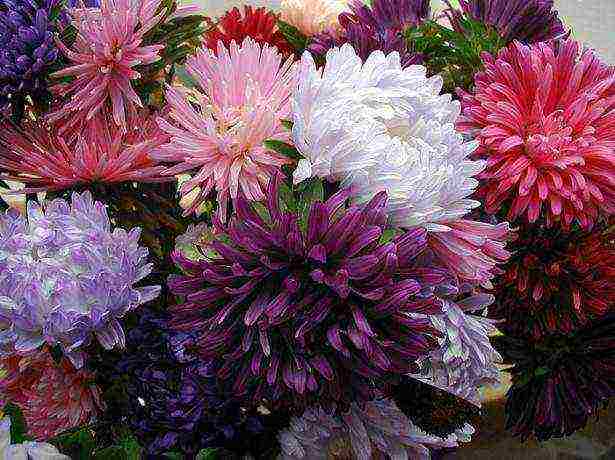
To decorate mixborders, rockeries, intricate flower beds and simple borders, asters are often used, the varieties of which are very diverse.
According to the generally accepted classification, asters are divided into classes: Reed, Tubular and Transitional. In turn, the three classes are divided in accordance with the structural features of the inflorescences into ten main types:
- Simple - non-double inflorescences, represent one or two rows of reed flowers with the center of the basket, consisting of small tubular yellow flowers;
- Tubular - the petals of the inflorescences, rolled into a tube, can be long or short;
- Radial - ligulate flowers, narrow, twisted, but not accrete;
- Semi-double - at least two rows of reed flowers are collected in the inflorescences, the disc consists of tubular flowers of various shades;
- Needle-like narrow ligulate flowers twisted along their entire length;
- Curly - wide ligulate flowers are decorated at the ends with light curls;
- Hemispherical - flat, wide flowers directed upwards;
- Coronal - along the edge there are several rows of reeds of flowers, in the center are collected tubular long flowers;
- Spherical - have densely double inflorescences, which consist of short wide ligulate flowers, and along the edge of the flowers are bent outward, and in the center they are directed upward, which is why the inflorescence resembles a lush ball;
- Tiled - with short wide ligulate flowers, the edges of which are bent outward, like a tile.
Video about growing and caring for asters
Among the listed types, individual varieties or groups are distinguished, depending on the shape of the inflorescences, flowers and the bush itself.
The most common varieties of annual asters
Favorite by many gardeners, the annual aster, or scientifically Callistephus Chinese, is represented by a huge variety of varieties. Ostrich feather, Bouquet princess, Victoria, Gigantic, Duchess, American beauty - these are just some of the most popular varieties of annual asters. An inexperienced grower can easily be confused by the wide range of shades and shapes of inflorescences! Therefore, before you go for seeds, decide where you will plant the purchased asters, and what color of flowers it is better to choose so that the overall picture in the flower garden turns out to be harmonious.
So, undersized cultivars (up to 25 cm high) are suitable for decorating paths in the garden, flower beds and flower beds. The dwarf Royal aster, belonging to the tiled type of asters, with graceful double lavender blue, bright pink or red flowers with a diameter of about five centimeters and narrow leaves, is especially in demand for creating borders. Needle undersized asters of the following varieties are also found in the flower beds and flower beds: Baby curb (bright pink flowers), Summer (pale pink color), Vologda lace (with white flowers), Autumn Olympics (blue asters).
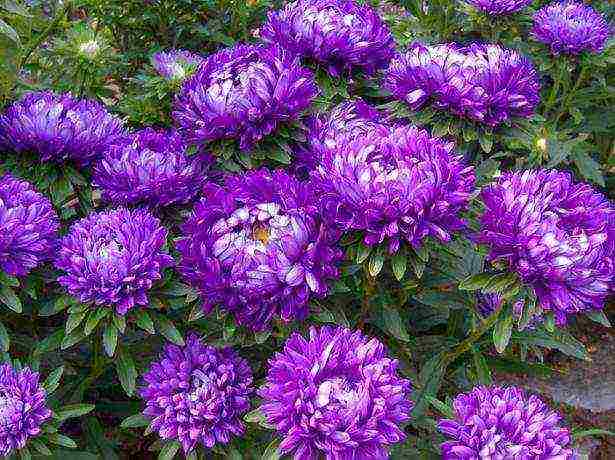
Annual asters
Medium and tall varieties of asters (up to 80 cm) can be planted in a flower garden in separate groups - usually they are grown for cutting. Terry varieties of asters look most effective, for example, pion-shaped aster with large hemispherical flowers, located 10-12 pieces on a columnar bush. Among the peony varieties, the following are popular: White and Blue Tower, Apollonia Heavenly, Roseanne, Gala, Violet turm. Of the needle-like tall asters, it is worth noting: Naina, Assol, Night Star, Belaya Nika, Timiryazevka, Jubilee White, Blue-eyed, Blue Frost, Isadora. Pompon asters: Yellow Beatrice, Hai no Maru, Winter cherry, Harlequin, Foyertot.
Popular asters perennials
The perennial garden aster has recently become widespread in the flower beds of our florists. However, you probably remember the delicate "septenchinks" of lilac, blue and violet shades that bloom in the gardens of our mothers and grandmothers by the beginning of autumn. These unpretentious plants up to 130 cm in height are also known as new belgian asters... Among the most common varieties: Beachwood Rivel (purple-red flowers), Dick Ballard (pink shades), Saturn (light blue color), Amethyst (dark purple double flowers), Oktoberfest (double blue flowers).
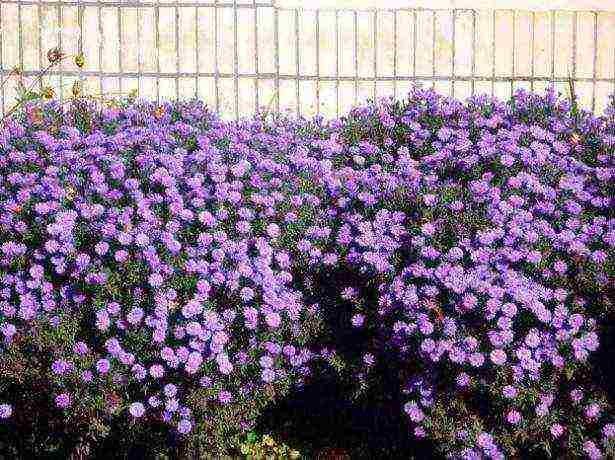
Perennial asters
With the New Belgian aster, it is similar in appearance and size of the bush aster new english... Popular varieties: Lily Fardell (deep pink asters), Dr. Eckener (red-violet color), Brownman (purple flowers), Rote Stern (dark red shades), Garpington Pink (light grove flowers).
Thanks to its bright, abundant flowering, New England Aster is excellent for the middle and background when creating mixborders. In the flower garden, it is better to plant companion flowers to it, which will cover the stems that are bare from below and will not allow the bush to disintegrate to the sides.
Video about how to sow asters before winter
Low-growing can be used for curbs. shrub aster, the height of which varies from 20 cm to 50 cm. Due to the abundant dark green foliage, the plant resembles a boxwood and even in a non-flowering state looks very attractive. In addition, you do not need to cut the shrub aster when decorating the borders, it is enough to trim it a little.
The choice of varieties is quite varied: light blue Blue Bird asters, white reed flowers of Niobe and Alba flora Plena varieties, lilac inflorescences of Dwarf Nancy, crimson Royal Ruby asters and compact bushes with pink-purple Venus flowers.
But if the above varieties of perennial asters bloom only at the end of summer, then alpine aster begins to delight with its charming little flowers of bluish-lilac and pinkish shades from May-June. Compact bushes with slightly pubescent stems reach a height of 30 cm, miniature flowers resemble multi-colored daisies with a bright yellow central part.
The most popular varieties (Dunkle Schone, Alba, Ruber, Glory, Superbus, Goliath, Rosea) are often used to create mixborders, alpine slides, curbs and landscaping balconies and terraces.
For Russians, the acquaintance with aster, or rather the Chinese callistephus (Callistephus chinensis), took place in the eighteenth and nineteenth centuries. The seeds were brought from Europe, where they came from China at the beginning of the 18th century. The first terry asters were bred in France.
Now there are over 4 thousand varieties of asters belonging to more than 40 groups. The most widely used are about 200 varieties from 20 groups. Breeders of Japan, Germany, England, USA, Czech Republic, France, Russia are working on the creation of new varieties.
By the nature of use, they are distinguished shearing, casing and universal grades.
- Cutting varieties have large inflorescences on long, strong peduncles.
- Casing plants have low compact bushes with a large number of long-flowering inflorescences, many of these varieties are suitable for growing in pots.
- Universal varieties are used both for cutting and for planting in flower gardens and iksborders, they have a long, durable peduncle and a compact bush.
Get to know the latest advances in aster breeding.
Universal type series
Old lock (10 colors)
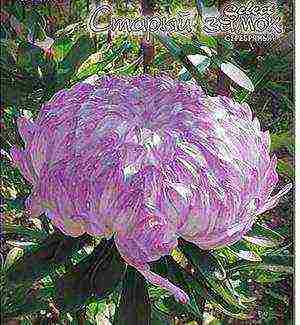
Plants 65-70 cm high, bush diameter 20-21 cm. On the main shoot 5-6 first-order shoots are formed with double inflorescences of a hemispherical farm. The diameter of the inflorescences is 10 cm, they consist of pseudo-ligate navicular flowers. From the moment of sowing seeds to the beginning of flowering passage 85-90 days, flowering lasts 40-45 days.
The Dragon (11 colors)
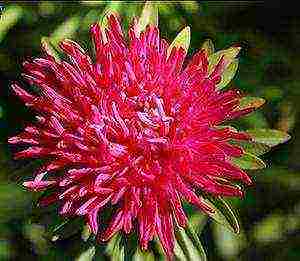
A great series for all-purpose use. Bushes 65-67 cm high, 25-30 cm in diameter. Inflorescences are large (12-13 cm), high degree of doubleness. The flowers in the inflorescence are bent inside the basket, so the inflorescence resembles a chrysanthemum. The period from sowing seeds to flowering is 100-110 days, from the beginning of flowering to the loss of decorativeness - 38-42 days.
Camelot (6 colors)
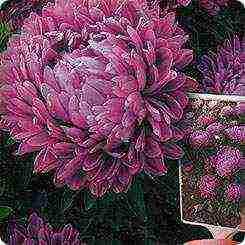
New variety series of English selection with exceptional decorative qualities. Asters of this group form low (25-30 cm) pyramidal bushes. Inflorescences with a diameter of 12-14 cm, of the original structure, this is a transitional form from the Old Castle group to the Dragon group. Good rain resistance.
Lady coral (9 colors)
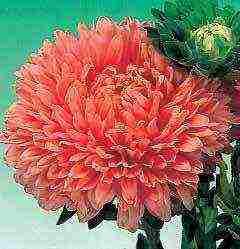
Breeding 2003 A fundamentally new, spectacular variety series. Mossy plants 60-70 cm high form many magnificent double flowers. The flowers are large, 12-16 cm in diameter. An important feature of the series is the exceptional density of inflorescences, the flowers practically do not suffer from rain and can stand in cut for a very long time.
Starfish (6 colors)
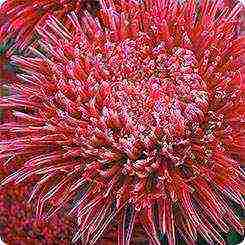
A fundamentally new type of radiant aster of German selection in 2004. A feature of the series is a unique type of inflorescences. The periphery is formed by long narrow petals, and the core is formed by unusual openwork flowers that resemble the legs of starfish.
In addition, the varieties of this series are characterized by a spectacular two-tone color of inflorescences. The plant is 60-70 cm tall, the diameter of the inflorescences is 12-16 cm. Each bush forms a much larger number of flowers than radiant asters or princess.
Fairy-type series
Biedermeier (4 colors)

A variety series of beautiful bouquet asters of traditional German breeding. Plants 40-50 cm high form dozens of delicate inflorescences about 5 cm in diameter. One plant - one bouquet.
Serenade (6 colors)

This is the newest variety series of Japanese selection with unusual bouquet-flowering bushes. The branching of the bush is very intensive, 20-30 second-order shoots are formed. During flowering, the bush is strewn with small, 2-3 cm in diameter, flowers. One plant produces 80-100 flowers.
Shanghai rose (2 colors)

Giant cut aster, intermediate in type between peony and princess. Plant height 60-80 cm. Forms double bicolor inflorescences of exceptional size and shape.
Valkyrie (12 colors)
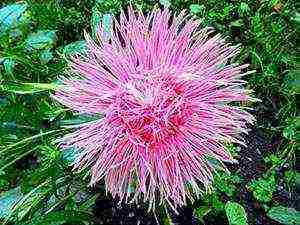
One of the best cross-sectional series. Plants are grown in separate groups, in mixborders and cut beds. The height of the bush is 60–65 cm, diameter is 30–40 cm. Inflorescences are 12–14 cm in diameter, they are formed by long reed flowers, twisted into a tube. Flowering begins on the 85-90th day after sowing the seeds and lasts 35-38 days.
Matador (5 colors)

This series of asters stands out from the rest by the power of the bush (its height is 80-90 cm) and large inflorescences - 15-18 cm. The inflorescence consists of 2 types of flowers. The outer part of the basket is formed by pseudo-lingual scaphoid flowers, and the inner part by pseudo-lingual, twisted into a tube. From sowing seeds to flowering, 110-115 days pass, the flowers lose their decorative effect 45-50 days after the beginning of flowering.
Merlin (3 colors)
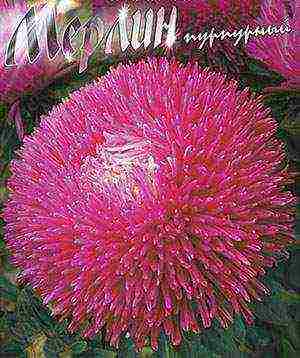
The newest series of asters. A characteristic feature of this series, like the Matador series, is the size of the bush and inflorescences. Plants reach a height of 70-75 cm, and almost spherical inflorescences, consisting of flowers twisted into a tube, resemble a coiled hedgehog. Diameter of inflorescences 16-18 cm. The period from sowing seeds to flowering is 90-95 days, flowering lasts 36-38 days.
Bullfighting (8 colors)
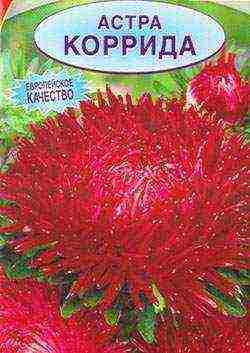
A new variety series of tall large-flowered sreech asters. The plant forms a bush up to 80 cm high and 25-30 cm in diameter. On one plant 0-7 inflorescences up to 14 cm in diameter. Asters of this group are also good for group plantings.
Series for the decoration of borders, flower beds, rabatok
Classic (7 colors)
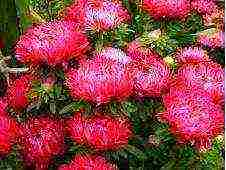
A variety of low-growing classic asters, perfect for growing in flower beds, irreplaceable as balcony and flowerpot plants. Asters of this series form sprawling bushes 25-30 cm high, inflorescences 8-10 cm in diameter.
Ribbon (2 colors)
Unique aster of German selection. Each petal is two-colored, with a bright longitudinal stripe. Plants are compact, 35-40 cm tall, with large spherical inflorescences.Not very rain resistant. Available only in 2 colors - red and blue.
Aster, aster cultivation, which variety of asters to choose
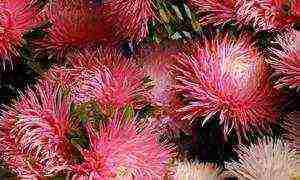 Asters are widespread in our gardens. These flowers are loved by most gardeners, so asters can be seen in a variety of varieties and shades. We offer you to familiarize yourself with the best varieties of asters, see photos of the most beautiful annual and perennial asters with a detailed description.
Asters are widespread in our gardens. These flowers are loved by most gardeners, so asters can be seen in a variety of varieties and shades. We offer you to familiarize yourself with the best varieties of asters, see photos of the most beautiful annual and perennial asters with a detailed description.
Aster flower: description
This culture is very popular with flower lovers. Translated from Greek, aster means "star". According to one of the legends, aster rose from stardust that fell from the sky... The Greeks believed that the flower brings good luck, so for them it was a kind of amulet. People tried to plant these flowers near a house or a temple.
Aster belongs to herbaceous perennial and annual plants of the Asteraceae or Asteraceae family. In nature, there are from 200 to 500 species of this flower. Most of them grows in Central and North America. Aster came to European countries from China.
The plant has simple leaves and inflorescences-baskets, which are collected in panicles or scutes. Depending on the variety flowers differ:
- coloring;
- the height of the bush;
- the shape of the leaves.
Basically this is a popular plant has needle-like flowers. Most often in our area, they are grown as annuals. Perennial varieties can also be found on sale. Any of the species has a beautiful and long flowering, good resistance to negative environmental conditions. They are drought-tolerant and light-loving plants. Almost all varieties shown in the photo have dense pedicels and beautiful inflorescences. Such characteristics of the flower are ideal for growing in the garden, creating landscaping.
Astra: the best perennial varieties
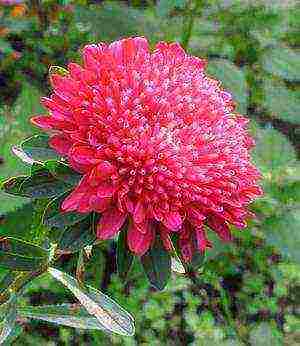 Most of all, among perennial asters, varieties that bloom in autumn are valued. They truly decorate the autumn garden, which quietly fades before the onset of winter. Perennial varieties differ variety of colors, the height of the bushes. Among them there are dwarf varieties that often adorn alpine slides and rockeries.
Most of all, among perennial asters, varieties that bloom in autumn are valued. They truly decorate the autumn garden, which quietly fades before the onset of winter. Perennial varieties differ variety of colors, the height of the bushes. Among them there are dwarf varieties that often adorn alpine slides and rockeries.
The flowering period for perennials, as well as for annual asters, begins in May and ends in November. Bushes of a wide variety of shades decorate flower beds abundantly strewn with inflorescences. After planting perennial varieties, they will delight the eye for 5 years without requiring much maintenance. After this period of time, it is advisable to transplant the bush to another place. Among the perennial asters there are varieties:
- early flowering;
- summer;
- autumn.
Now we will take a closer look at each of them with a description, names and photos.
Early flowering asters the best varieties
These asters bloom from May to June. They can often be seen on alpine slides in group and single plantings. Most popular alpine aster, which, thanks to the efforts of breeders, was bred in many species. They are distinguished by a large palette of shades, a flowering period. Unpretentious in care, for which they are popular with flower lovers.
Albus is a low-growing aster of white color, the height of the bush is no more than 30 cm. Stems with a large number of leaves reach a height of 20 cm. White inflorescences are always clearly visible against the background of the flower bed.
Dunkle Scheen - different fluffy inflorescence in the form of daisies dark purple in color. The inflorescences reach 3 cm in diameter. They look good in the form of a composition with other flowers and as a frame for the foot of an alpine slide. The plant is frost-resistant.
Happy End - flowers of a pale pink color. They adorn straight and short, but strong stems. The bush grows up to 25 cm and blooms for almost a month.
Glory - inflorescences, camomile sky blue. The diameter of the flower is up to 4 cm, against the background of which the yellow center stands out brightly. Most often it is planted near conifers, as well as in combination with white and yellow flowers.Looks good in single fit too.
Goliath - blooms in June with large light purple inflorescences, up to 6 cm in diameter. Delicate inflorescences delight the eye for a month with their beauty. They are often planted on alpine slides.
Summer "stars" varieties
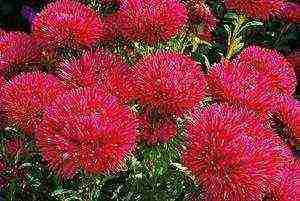 The average flowering period of the variety is distinguished by a higher growth. They reach a height of 30 to 70 cm. A bright representative of this group is the Italian aster. It is very often called chamomile. The height of the bushes allows you to plant it along the fence or as single bushes. Beautiful bright flowers are collected in shields, the diameter of which reaches 4 cm.Their color is distinguished by rich shades:
The average flowering period of the variety is distinguished by a higher growth. They reach a height of 30 to 70 cm. A bright representative of this group is the Italian aster. It is very often called chamomile. The height of the bushes allows you to plant it along the fence or as single bushes. Beautiful bright flowers are collected in shields, the diameter of which reaches 4 cm.Their color is distinguished by rich shades:
- blue;
- pink;
- light purple.
The flowering period of summer varieties begins in the month of June. They are often planted in rocky gardens and rockeries. To the most popular for planting asters include the following types.
Rosea - belongs to the longest flowering shrub asters. It begins to bloom in June and continues to delight the eye for three months. Medium-sized flowers with ligulate petals, have a pale pink tint. There are also tubulars of light brown color.
Lady Heindlip is one of the most popular varieties of prepresentatives of Italian asters. It has a rich pink color.
There is the Bessarabian aster, which is often also called falsely Italian. The bushes grow up to 75 cm in height with numerous dark purple flowers. Inside the flower there is a brown center.
Autumn varieties
 Late flowering includes several popular varieties - Shrub, New Belgian and New England. During this period, much more asters bloom.
Late flowering includes several popular varieties - Shrub, New Belgian and New England. During this period, much more asters bloom.
New Belgian asters can grow up to 1.5 meters. Shrubs have many branches with a lot of leaves. There are also almost glabrous stems with no deciduous mass. The color scheme is dominated by lilac-lilac shades, sometimes red and pink. The most common varieties look very beautiful in bouquets.
Amethyst blooms for about a month with dark purple semi-double flowers. On one stem, up to six flowers with ligulate petals.
Bellard is a great option for cutting in bouquets, as well as for planting in flower arrangements. Differs in lush color, therefore it is often used for single planting in flower beds. Flowers are medium-sized, bright pink in color.
Saturn - the bush reaches a height of one and a half meters. Lush blue inflorescences have a diameter of up to 4 cm and the flowering period lasts almost a month.
Perennial bush looks like compact but dense flowering bushes. They will grow up to half a meter in height. It blooms in early September and continues to give beauty until the onset of cold weather. The flowers are light purple or white. Most popular varieties planted as decorative deciduous plants. In addition to beautiful inflorescences, the bushes are distinguished by leafy stems. Some varieties do not have time to bloom due to climatic conditions in central Russia.
Blue Bird - his can be called dwarfas the height of the bush is only 25 cm. It is ideal for creating borders or a composition of low-growing plants as a central figure. The color can be sky blue and lilac shades.
Venus is also a dwarf bush up to 20 cm high. It is used as a hanging option to create floor pots and flower beds. Bloom later than all other varieties. The lilac-pink color of the inflorescences pleases with its beauty from September throughout the month.
New England asters unite at once a few main characteristics:
- strong bushes with straight stems;
- thick shoots;
- tall stems.
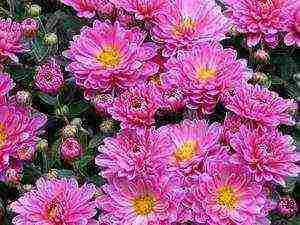 Brownman - the bush grows up to 1 meter in height and blooms in September. Lush inflorescences collected in lilac-violet brushes. The variety looks great in bouquets and flower beds. It is planted as a hedge.
Brownman - the bush grows up to 1 meter in height and blooms in September. Lush inflorescences collected in lilac-violet brushes. The variety looks great in bouquets and flower beds. It is planted as a hedge.
Dr. Ekenner - the height of the bushes reaches one and a half meters. This beautiful aster blooms with red-purple flowers, the diameter of which is 4 cm. The flowering period is almost 1 month, when all the flowers in the flowerbed have practically faded.
Rote Stern - is distinguished by large flowers of an unusual carmine shade. The height of the bush is up to one and a half meters, it blooms in the fall for 1 month.
Varieties of annual asters
The most popular variety of annuals is Chinese aster. The photo clearly shows the beauty of these vibrant colors. In the modern world, there are more than 600 species of this variety. All of them can be terry, semi-double and simple. In its form, this a variety of annual flowers can be:
- chrysonetemum;
- needle-like;
- spherical;
- pompom;
- pinkish;
- peony.
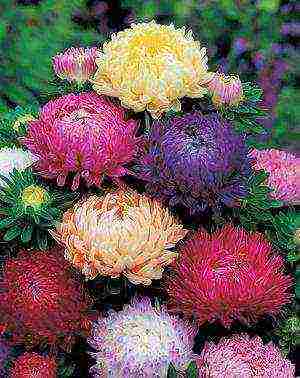 All varieties chinese asters look good as single bushes, and in the creation of compositions. Some of the most popular varieties of Chinese asters include:
All varieties chinese asters look good as single bushes, and in the creation of compositions. Some of the most popular varieties of Chinese asters include:
Galaxy - double needle-like inflorescences, 10 cm in diameter in various shades, the bush grows up to 70 cm;
Roseanne is a peony plant that can grow up to 65 cm. Pink flowers are distinguished by tightly pressed petals and curved in the middle;
Pomponnaya - has terry inflorescences of tubular elongated flowers. All these and many other varieties of annuals are easy to confuse with chrysanthemums or peonies, dahlias. You can figure it out only with the help of the classification of asters, but none of them is perfect.
Asters wide used in landscape design... They are always good for planting on a personal plot, flower beds of parks, decorating balconies, alpine slides. These flowers are always suitable for creating a bouquet.
Aster flower

